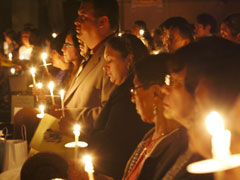 Often I find myself with the desire to read all available books on a given topic but with the time to only read one. Under such circumstances I hope to get a recommendation from a friend or colleague about where to start and I try to do the same for my sociology colleagues when they find themselves with a passing interest in religion. For those with an interest in the relationship between Hispanic demographic changes and American Catholicism, I’ll be recommending Timothy Matovina’s new book Latino Catholicism: Transformation in America’s Largest Church.
Often I find myself with the desire to read all available books on a given topic but with the time to only read one. Under such circumstances I hope to get a recommendation from a friend or colleague about where to start and I try to do the same for my sociology colleagues when they find themselves with a passing interest in religion. For those with an interest in the relationship between Hispanic demographic changes and American Catholicism, I’ll be recommending Timothy Matovina’s new book Latino Catholicism: Transformation in America’s Largest Church.
The book covers a range of issues ranging from ministry to religion and electoral politics and it brings together insights from the vast but scattered historical and sociological scholarship that exists on this topic. Folks looking for an exhaustive discussion of any one issue won’t be satisfied. For example, I wished there was more on Latinos and Catholic education. However, the book serves as a masterful overview.
The book really highlights the need for a more nuanced view of Hispanic Catholics. In the opening chapter, there is a good discussion of the perils of relying on an “Americanization” lens that worked for European immigrant groups in efforts to understand Latino Catholics. Matovina suggests the utility of using a more “hemispheric” perspective. Throughout the book, Matovina takes pains to highlight the importance of moving beyond a monolithic treatment of Latinos. National origin and immigrant-generation are important sources of difference in belief and practice. I’ll note here just two (very different) examples of how this matters. First, Hispanics of Argentinean, Chilean, and Brazilian ancestry are disproportionately represented as clergy and lay leaders, likely as a function of that that immigrants from these nations tend to arrive with higher levels of income and education. Secondly, second-generation Hispanic youth are more likely to engage in risky behaviors such as drinking than their immigrant peers.
Among the topics covered in the book are the historical origins of Latino Catholicism in the United States, debates over integration and assimilation, issues in ministry, Enceuentros, Latino philanthropy, vocations, the Cursillo movement, Latino Protestants, and the religious lives of Latino youth. One of the findings that I found most striking is the relatively low levels of vocations among Latinos. There are roughly 3000 Spanish-speaking priests working in the U.S. but few of these are American born Hispanics. While I did know that Hispanics have been underrepresented in the church hierarchy I was unsure the exact figure and had never considered the possibility that the size of the “candidate pool” might be small. According to Matovina’s reading of the documents, there are 35 active Hispanic bishops in the United States. They account for less than 10 percent of active bishops and all are located in dioceses in the West or Southwest.
All in all, it is hard to find faults in this work. I did not personally like the font used at the beginning of each chapter or the cover graphic. That I am even mentioning this is a sign that this book leaves little to criticize and deserves much praise. While this book does not provide “conclusions” it does serve as an important starting point for a discussion of this increasingly important issue. As Matovina notes, the Roman Catholic Church in the United States is the most ethnically and racially diverse national ecclesial body in the world. Hopefully more analyses will build upon this overview and explore the implications of these changes.